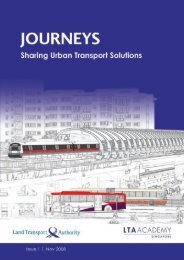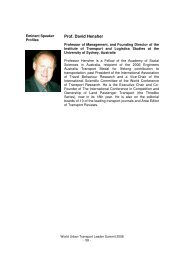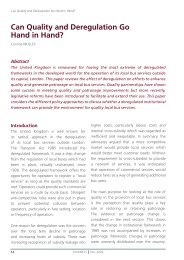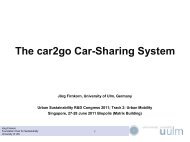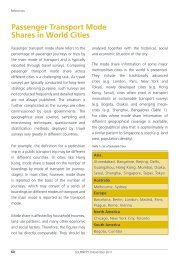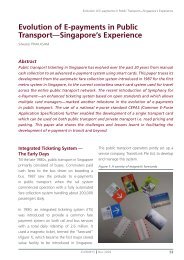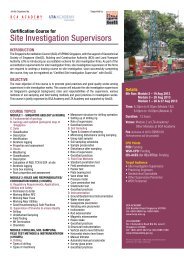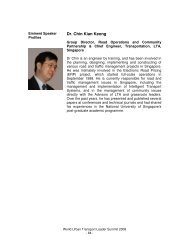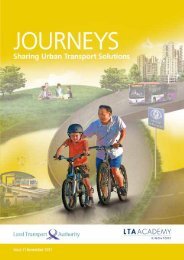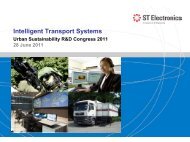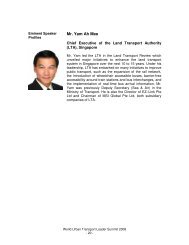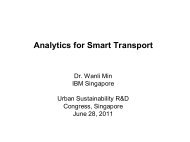Issue 4 May 2010 - LTA Academy
Issue 4 May 2010 - LTA Academy
Issue 4 May 2010 - LTA Academy
Create successful ePaper yourself
Turn your PDF publications into a flip-book with our unique Google optimized e-Paper software.
Urban Transportation Planning for a Vibrant and Distinctive Singapore<br />
project to come to fruition. Singaporeans<br />
have to actively “buy-in” to the rewards of<br />
EVs and their attendant benefits. One of the<br />
low hanging fruits would be the creation of<br />
the first consumer-oriented market place for<br />
carbon emissions in the world; it is possible<br />
that private equity, whether from Singapore<br />
or other financial centres, can be used to<br />
lubricate the transition process and help<br />
to pay for the government investments in<br />
the transition to EVs. The potential job and<br />
revenue spin-offs from participating in the<br />
carbon markets have been addressed by Tilak<br />
Doshi (2009). But once again, there has to<br />
be a concerted political effort to analyse the<br />
macro-economic impact of implementing a<br />
carbon marketplace/taxation effort. But as<br />
we work the carbon tax or cap-n-trade issues,<br />
consider its impact (negative?) on Singapore’s<br />
petro-chemical and international logistics<br />
sector which generate a majority of the<br />
carbon emissions in operations and bunkering<br />
while contributing tremendously to the islandstate’s<br />
economy.<br />
Changing the industrial<br />
architecture of road vehicle<br />
electrification<br />
The much touted association between EVs<br />
and renewable energy sources, such as, wind<br />
and solar lies in the usage of the electricity<br />
storage capacity of these vehicles when they<br />
are at rest, known as V2G (Anderson 2009).<br />
Essentially, the vehicles absorb the electricity<br />
generated by renewable sources and redistribute<br />
it through the national grid; this<br />
helps to offset the peaks and troughs for<br />
renewable energy generation at all hours of<br />
the day.<br />
48<br />
JOURNEYS <strong>May</strong> <strong>2010</strong><br />
EVs are now fashionably touted in<br />
the international arena... We contend<br />
that a holistic “systems of systems”<br />
technological and economic study be<br />
conducted to make the public fully<br />
aware of the social and economic cost<br />
of implementing such policies.<br />
Figure 5 illustrates the uneven nature of<br />
energy generation of the wind energy sector<br />
in Denmark, which theoretically could be<br />
offset by V2G technology.<br />
The complication lies in the implementation<br />
of this technique in Singapore. The amount<br />
of electricity generated by renewable energy<br />
remains negligible in the domestic Singapore<br />
electricity market, as mentioned earlier; natural<br />
gas powered turbines which are much more<br />
regular in energy generation remain the status<br />
quo. Hence, implementing a V2G solution<br />
would have much more different implications<br />
for the supply and demand structure of the<br />
power grid locally.<br />
Singapore is accustomed to separating the<br />
energy demand for transportation and<br />
electrical power. Combining these two areas<br />
means that an entirely new perspective on<br />
energy has to be formed; we will be witnessing<br />
a rapid increase in demand for electricity at all<br />
hours. The market case for renewable energy<br />
sources remains to be proven in the Singapore<br />
context and further investigation into its<br />
reliability in providing concentrated power<br />
for distributed, private transportation remains<br />
to be seen. <strong>LTA</strong> could collaborate with public



